
Updated 14 August 2017

|
Updated 14 August 2017 |
|
HOME PAGES GLOBAL WARMING WHAT YOU CAN DO GREEN ISSUES BACKGROUND THE INITIATIVE |
This page discusses the options for lighting a home, focusing on reducing energy use: incandescent bulbs, halogen lamps, and lower-energy choices – fluorescent tubes, compact fluorescent (often called low-energy) bulbs and light-emitting diodes. A table summarises some main features. There is a list of suggested bulb wattages for low-energy bulbs, and an actual case study shows how much energy and money can be saved by using low-energy lighting. Finally, some information on suppliers, since shops only tend to stock the most common types and sizes. Introduction 
Lighting represents a surprisingly large part of the electricity consumption of a typical house. We begin with a quick summary of the domestic lighting situation, emphasising the advantages and disadvantages of different types of low-energy lighting. More detailed information is given in the sections that follow. Units of light output Light bulb, fluorescent tube and LED packages now must indicate their light output, using units called lumens. This makes it much easier to compare different models, wattages and sizes. The differences between nominally similar bulbs can be considerable, so this is useful if you are worried about getting bright enough lighting. However, be careful to compare like with like – the comparison is not valid when comparing, say, a bulb or tube that spreads its light in all directions with a directional spotlight. Incandescent bulbs Incandescent bulbs are the traditional light bulbs, at right in the photo. They are still being used, although the most common types are no longer on sale. They are a flexible source of lighting which is cheap to install but expensive to run, because most of the energy consumed is turned into heat rather than light and their lifetime is relatively short. Due to their inefficiency only specialised types can still be sold. Halogen lamps Halogen lamps are basically improved incandescents. They produce whiter, brighter light from a very compact package but are more expensive. However, they still waste most of the energy as heat. So-called ‘energy-saving’ or ‘eco’ halogen bulbs are only a small improvement, saving about 30%. Fluorescent tubes Fluorescents are the original low-energy light source, used for many years in kitchens, utility rooms and garages. They are about four times as efficient as incandescent lights, and last much longer. Modern fluorescent tubes (most notably T5 types) have improved efficiency, and in addition to long tubes there is now a variety of more compact shapes. Old-fashioned magnetic ballasts and starters are now replaced by electronic fittings. This increases efficiency and avoids flicker and hum, as well as starting up instantly. Some types of fluorescent fittings can be dimmed. Modern versions are a big improvement; they are widely used in shops, offices, and public and commercial buildings but not so much in homes. * Fluorescent tubes are a good option from the energy and cost point of view where bright overall lighting is needed. Compact fluorescent lamps (CFLs) CFLs (usually called low-energy bulbs) are now available in a wide range of sizes and shapes, such as in the photo above at left. Similar in operation to fluorescent tubes, they are designed to work in simple light fittings like those used for incandescent bulbs – the ballast and starter are built into the bulb. They are about four times as efficient as incandescent bulbs and last much longer, so are much cheaper over their lifetime. The drawbacks, which are much reduced in recent models, are that they are dim for a short time after switching on, and most models are insuitable for use with dimmer switches. If they can be dimmed, this will be stated on the packaging. Suggested wattage ratings are often too low, so a realistic wattage list is given below. A real example of the possible cost and energy savings with CFLs is also given. * Low-energy bulbs (CFLs) are currently a good option from the energy and cost point of view for omni-directional domestic lighting, especially where they are replacing high-wattage incandescent bulbs (e.g. more than 60–80 watts). Light-emitting diodes (LEDs) LEDs are electronic devices that are evolving rapidly – their frugal use of energy already makes them the most efficient light source. Although still expensive, costs are coming down steadily. They are excellent for small, battery-powered devices, such as portable torches and bicycles. They come on instantly, some models can be dimmed, they produce very little heat, and have extremely long lifetimes. Warm white versions are now available in addition to the original blue-ish light. For domestic applications they are already the best choice for replacing directional lighting, such as the widely used halogen spotlights. However, more widespread use requires a wider range of omni-directional LED bulbs with high light output on sale, and further reductions in their prices. The nature of LEDs could also open interesting creative possibilities due to not needing discrete bulbs or tubes. * Light-emitting diodes (LEDs) are the future of lighting. They already offer a longer-lived, much more efficient replacement for halogen spotlights. For omni-directional lighting the range of lamps available and their cost must is rapidly becoming attractive. Cost has been omitted as prices, especially of LEDs, are coming down rapidly.

Incandescent lighting, the oldest source of electric light, is still used in many homes. The light comes from a fine filament, normally of tungsten, which is heated electrically until it gives off visible light. The filament is usually in the centre of a glass bulb, evacuated to minimise heat loss through convection. The filament evaporates at a rate strongly dependent on temperature, but higher temperatures give more visible light for the input energy. Thus there is a compromise between the life of the bulb and its efficiency. The normal compromise gives a life of about 1000 hours, though big power fluctuations can cause premature failure. Long-life bulbs last longer but give less light for the same electricity consumption. The light is a warm white, with more red than blue in the spectrum. Some lamps are filled with an inert gas such as argon. This allows a higher temperature for the same lamp life. Efficiency 
Incandescent lamps are inexpensive. However, they radiate most energy in the infrared (i.e. as heat) and are inefficient for generating visible light, so they are expensive to run. Lower power lamps and torch bulbs are particularly inefficient. A common argument used in their favour is that they help to heat the room they are in so the heat is not all wasted. However, this ignores the facts that this heat comes from full-price electricity (one of the worst ways to heat a house), and also that the room might not need heating. Because they are so inefficient, standard types have been been banned from sale. Some shops sell ‘industrial’ quality bulbs at fairly high prices to evade the law. The lamps start generating close to their full output in a fraction of a second after they are switched on. They can be dimmed easily by reducing the temperature of the filament, either by reducing the voltage across the lamp or by pulsing the current supplied. An incandescent lamp on 50 Hz mains electricity has a slight flicker, but this is not noticeable as the filament does not cool much between cycles. Fittings and types Two fittings for mains-driven incandescent lamps predominate in the UK, as shown in the pictures. Bayonet Cap (BC), fitting code B22d, is the most common. Edison Screw (ES), code E27, is less common in the UK but more widely used elsewhere; many imported lamps and light fittings use it. Other fittings include the Small Edison Screw (SES), code E14, Small Bayonet Cap (SBC), and striplights of either 221mm or 284 mm length. The main kinds of lamp are regular, candle, reflectors (spotlights) in various sizes, globes, and striplights. End of life Incandescent lamps consist of glass and metal. They do not contain any materials that will harm the environment, so they can be thrown away with household waste. They should not be placed in containers for recycled glass, however, because the glass used for these lamps is not the same as the glass used for bottles. Conclusion * Although easy to use and cheap to make, ordinary incandescent bulbs are the most inefficient and expensive source of domestic lighting. Their sale has been banned, so that only specialised types are still available. 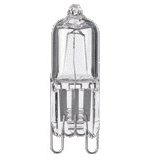
Halogen lamps are incandescent lamps in which the evaporation of the filament is reduced, giving a brighter light and a longer life. The bulb is filled with an inert gas containing a trace of a halogen such as iodine. The tungsten on the filament evaporates slowly and is deposited on the inner surface of the bulb. Provided the surface is hot enough, the iodine reacts with the tungsten to make a gas, which is then broken down by the heat of the filament to redeposit the tungsten on the filament. The design lifetime is normally about 2000 hours. Halogen bulbs are usually made of quartz rather than glass, as this withstands the higher heat better. This very hot surface can be a safety concern. Ideally the bulb should not be touched directly, as grease from a finger on the quartz bulb can generate a hot spot which reduces the life of the lamp. Halogen lamps generate intense white light from quite small bulbs. They are used in outdoor floodlights and car headlights, as well as compact reading lamps and various low-voltage portable equipment. Some small bulbs include reflectors, and are very popular used as multiple spotlights giving bright, directed light in restaurants, kitchens, bathrooms, etc. Efficiency 
Halogen lamps provide up to twice as much visible light as a normal incandescent bulb of the same wattage, and as the filament is hotter the light spectrum is bluer and closer to daylight. Their greater efficiency and longer life makes their overall operating cost potentially cheaper than normal incandescent lights. However, the tendency is to use halogen lights with higher power than the incandescent lamps they might replace, which nullifies any energy saving. They are dearer than normal incandescents, with bulbs costing from about £3 upwards. Some more efficient, so-called low-energy, or ‘eco’, halogen bulbs have started to appear, but as the energy saving is only about 30% this progress is welcome but certainly not a major step. Halogen lights can be dimmed, but since the method of maintaining the filament depends on having a hot bulb they are not ideal for dimming. Fittings and types There is a huge variety of bulb types. Some operate at mains voltage, but even for normal domestic use many light fittings include transformers so that the bulbs operate at low voltage. This makes wiring easier and safer, but if the transformers are not switched off there is some continuously wasted energy. Common types are small capsules or bulbs, and lights with reflectors (e.g. GU10; see pictures), as well as the small, thin tubes used in outdoor floodlights. End of life Halogen lamps contain very small quantities of halogens and halogen-hydrogen compounds, but the amounts are insignificant (only a few millionths of a gram). The lamps can therefore be thrown away with household waste. As they are made from quartz they cannot be recycled with glass. EU ban on halogen lighting The EU had planned to ban halogen bulbs by 2016, but despite a rapidly growing range of LED replacement bulbs this has been delayed to 2018. This is claimed to be so that the full range of available lamp types will be replaceable by LEDs. Conclusion * Although more efficient than ordinary incandescent bulbs, halogen lamps are also unacceptably wasteful of energy and expensive to run compared to other light sources. A fluorescent tube generates light by creating a plasma in mercury vapour contained in a glass tube. The plasma generates ultraviolet radiation. The inside surface of the tube is coated with a fluorescent phosphor which absorbs the ultraviolet and generates visible light. The colours generated depend on the phosphors used. Typically the light is concentrated on a few colours, for example yellow and blue, and the human eye interprets this as white. Fluorescents for general use typically produce one of several colour blends:
Because of the peaky spectrum of light generated, colours viewed under fluorescent light often differ from their colours in daylight – in particular reds can look darker. Tubes with three phosphors (triphosphor) have better colour rendition as well as typically being brighter. In domestic use, many houses use fluorescent tubes in kitchens, utility rooms, garages and bathrooms. They are used much less often in living rooms, bedrooms, etc. as fluorescent light and fittings often seem colder and more ‘industrial’ – using warm white tubes can help with this. Ultraviolet lamps omit the phosphor and transmit the ultraviolet radiation directly. They are used for disinfection chambers and sun beds. Black-light fluorescents convert the original ultraviolet light into the near ultraviolet, which can then generate strange theatrical effects when shined on paints and other materials which fluoresce in visible colours. This section discusses the traditional fluorescent tubes that have been available for many years (two photos at left, below) as well as improved modern varieties (two photos at right), while low-energy bulbs (properly called compact fluorescents) are treated separately in the next section. The important distinction is that compact low-energy bulbs work in the same fittings as incandescents, while other fluorescents need dedicated fittings. Efficiency The main advantages of fluorescent lights over ordinary or halogen incandescent lamps are that they generate much more visible light for the same input energy, last much longer, and their surface is much cooler. A rough rule is that they use only about a quarter as much energy as incandescents to produce the same amount of light. However, the light output often depends on the colour balance – the cooler mixes tend to be more efficient than the redder ones, so for example a white tube will usually produce more light than a warm white one of the same wattage. However, there are slightly more expensive triphosphor warm white variants (e.g. GE Polylux XLR) that do produce more light as well as claiming improved lifetime. It is also worth noting that it can take a fluorescent a few moments to come up to full intensity, especially in a cold environment, and that the light output drops by about 20% over the life of the tube. The typical lifetime is usually stated to be about 10,000 hours, with some tubes claiming 15,000 or even 30,000 hours, but this depends on how often the tube is switched on and off – sometimes a life of 50,000 on/off cycles is claimed. The oldest types of fluorescent tubes have been phased out under EU legislation, replaced by compatible tubes with more efficient phosphors. These can reduce power consumption by about 10%. It is also possible to replace a conventional starter with an inexpensive electronic plug-in canister (e.g. Philips Power Saver Set). Combined with more efficient tubes, the consumption is then reduced by about 30%. 
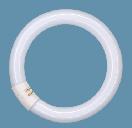

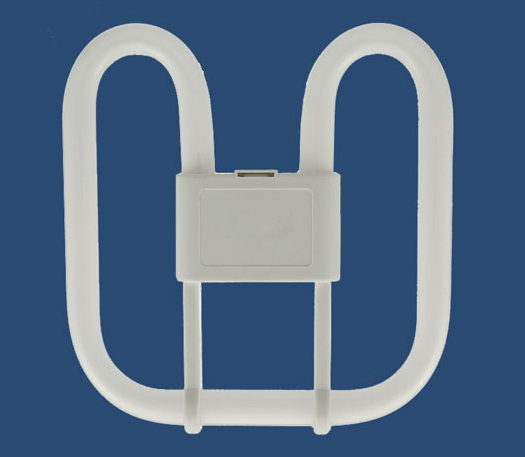
Fittings and types Fluorescents require extra equipment in addition to the tube. In older-style fittings a starter heats electrodes at each end and then opens the circuit. This triggers a spike of voltage to start the plasma, which often flickers on and off a few times before becoming continuous. A magnetic ballast (consisting of an inductor) assists in generating the initial spike, and then limits the current in the tube, which otherwise would become excessive after the plasma has been created. Such fittings sometimes flicker and hum in an irritating way at 100 Hz, especially as they age. The light can cause moving machinery to appear stationary. The EU is phasing out this older type of fitting. Modern fittings have electronic ballasts with no separate starter, and operate at higher frequency (e.g. 25,000 Hz). The light comes on instantly without flickering, and annoying hum and flicker are less of a problem. Electronic ballasts can be designed to support dimming of fluorescents, keeping the filament hot while reducing the current across the tube. However for this to work there must be a good match between the dimming control and the tube. Some lights with integral ballast have been developed to provide dimming in conjunction with incandescent dimmers. The flickering of some old-style fluorescent fittings disturbed some people, causing migraines and sometimes triggering epileptic fits. This should be better with the modern fittings. Despite some claims, evidence that this is still a problem is sparse. Conventional fluorescent tubes come in a variety of lengths and diameters. The main types, based on tube diameter, are:
A standard fluorescent tube costs from about £3. For example, a 58-watt tube (often used in kitchens or utility rooms) might cost £5, with a warm white version offering more light output and longer lifetime for £6. Labels must indicate how much light they produce, in lumens. More unusual designs can cost up to perhaps £15. Wherever possible use newer high-efficiency triphosphor types for more light and better colour rendition while using the same or less energy. The range of tubes and fittings in DIY or electrical shops tends to be quite limited, but a list of online suppliers is given below. A limited range of direct replacements for fluorescent tubes that are based on LEDs are becoming available. These have all the advantages mentioned in the LED section, but at present are expensive to buy. Recent developments In recent years a number of more compact and efficient designs using different tube configurations have appeared (examples are shown in the right-hand two photos above). Sometimes confusingly called compact fluorescents, these differ from the low-energy bulbs (CFLs) described below because, like traditional fluorescents, they do not include a ballast in the tubes and so cannot be used in incandescent-type fittings. Some of these have four pins and others only two; the ones with two pins have built-in starters. Examples are shown in the two pictures at right. Often used in low-energy light fittings, they are required by some UK building regulations to prevent use of incandescent replacements There are ceiling lights that use several parallel, shorter tubes in recessed reflector fittings that are designed to maximise light output to the room. These are mainly designed for public buildings and offices (typically with false ceilings) rather than domestic use. However, some newer wall-mounted designs are quite acceptable for domestic living areas. These use fairly short tubes, sometimes bent to form an extended closed shape, as in the picture, and placed behind a glass or plastic diffuser. These fittings produce a lot of light and lie fairly flat on the wall; they are on sale in DIY and electrical shops. End of life Fluorescent tubes contain some mercury (less than they used to) and so require special treatment, available at local waste disposal centres. Do not put them in with your normal rubbish. If you break a fluorescent tube, ventilate the room well before cleaning it up to avoid inhaling mercury vapour. Conclusion * Fluorescent tubes are a very effective way to reduce
both energy usage and costs. Compact Fluorescent Lamps (CFLs, or Low-Energy Bulbs) Compact fluorescent lamps are low-energy light bulbs that can be used as direct replacements for conventional bulbs. A CFL has an integral electronic ballast and starter, and typically either a bayonet or Edison screw fitting so it can be used in the same fittings as incandescent bulbs. This section concentrates on CFLs, often simply called low-energy bulbs – more conventional fluorescent tubes requiring fittings with separate ballasts are discussed in the previous section. 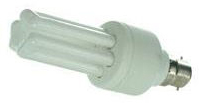
When CFLs were introduced they were too big and heavy for many existing light fittings, and cost £10 or more. They took quite some time to reach full brightness, and usually produced less light than expected. Current models are far better. They brighten up much more quickly, produce more light, and come in a variety of shapes (see photos at right): both the original straight tubes and very compact spirals that fit into many existing light fittings. They are also much lighter in weight. Other shapes are also available, such as globes and candle lamps. CFLs that can be dimmed are now available but they cost more and are not as widely available. Although seldom seen in the shops, CFLs of up to about 30 watts are available for domestic use, providing replacements for incandescent bulbs up to about 150 watts. Costs have come down, but the frequent special offers of ultra-low prices, often sponsored by energy suppliers to meet their obligations to reduce energy use, are gone. Typical prices are a few pounds each. However, CFLs are still noticeably less bright in cold surroundings, and are not always the best choice for locations where they are only switched on for very short periods (e.g. a cupboard). 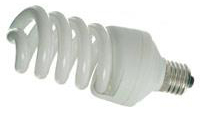
Efficiency CFLs share the advantages of fluorescent tubes. The much more compact packages do somewhat reduce the amount of light produced for a given amount of energy, but compared to incandescents the energy usage, running cost and lifetime are vastly improved – see the real-life example below. The energy saving is so large that they pay for themselves within a few months. And although one CFL might cost more to buy than one conventional bulb used to, the far longer lifetime means that the cost of buying one CFL should really be compared to buying about ten incandescent bulbs. However, beware of buying cheap, possibly unbranded, bulbs with efficiency ratings of B rather than A and lifetimes of less then 10,000 hours. Many people have noticed that the wattage equivalents claimed on CFL packaging tend to be overstated. These usually suggest replacing an incandescent bulb by a CFL with a wattage rating of one-fifth or less. Unfortunately the worst example is the most common one, replacing a 60 watt incandescent by an 11 watt CFL. This is often not bright enough, which discourages people from using CFLs, and leads to the very common statements that CFLs cannot provide adequate lighting. It is usually better to go up to the next available rating, using a CFL with about one-quarter of the wattage rather than one-fifth – for example replacing a 60 watt incandescent bulb with a 14 or 15 watt CFL, or a 100 watt incandescent with about a 23–25 watt CFL. There is a suggested list of replacement wattages below. However, recent designs do have improved light output – labels must indicate the light output in lumens. Fittings and types 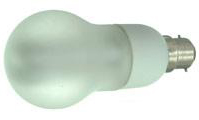
CFLs come in a wide and expanding variety of sizes and shapes, as shown in the pictures. However, if you want to put one into a constricted light fitting it often takes care to find a CFL of the right wattage that fits into the space available. The main styles currently available are: small U-tubes (two to four tubes), spiral, globe (like a conventional bulb), candle, and reflector. Many CFLs are Edison screw, and although some light fittings and lamps in the shops are also Edison screw, it is quite difficult to buy Edison screw replacement bulb sockets for fitting yourself. The most common ratings range from 7–8 watts up to about 23–25 watts. Larger sizes and a full range of shapes are harder to find in shops. For example, to replace a 150 watt conventional bulb a 30 watt CFL is recommended. A list of mainly online suppliers, offering a far wider range of bulbs and fittings, is given below. Another advantage of CFLs is that they produce much less heat than the equivalent incandescent bulb, so that a higher-wattage CFL can be used in a fitting that can only handle a relatively low-wattage incandescent. However, for CFLs of more than about 20 watts it is still necessary to be sure there is adequate ventilation. 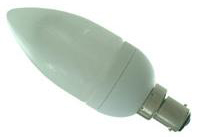
CFLs that can be used with conventional dimmer switches are not common but are available – they cost more and reports on their performance are mixed. There are also CFLs with light sensors built into their bases, so that they can automatically turn on at night. Although there are CFL replacements for halogen spotlights (e.g. GU10s), most are not bright enough and LEDs are now a better choice. Possible problems There have been some reports in the press about low-energy bulbs causing migraines and epileptic fits. Hard evidence on the number of occurrences and the exact types of bulb has not been given. Older fluorescent tubes could flicker and disturb some people, but modern fluorescent fittings and low-energy bulbs work differently so it is not clear whether this is really a problem. Prices Prices of low-energy bulbs are quite variable, so it is well worth shopping around. Unusual sizes and types may only be obtainable from specialist companies on the internet, and in any case are usually less expensive than in shops. Beware of cheap unbranded bulbs. Some of these work reasonably well, but others produce too little light or take a long time to reach full brightness. End of life Compact fluorescent lamps contain a very small amount of mercury (much less than they used to) and so require special treatment, available at local waste disposal centres. Do not put them in with your normal rubbish. If you break a bulb, ventilate the room well before cleaning it up to avoid inhaling mercury vapour. Most people who have replaced their bulbs with CFLs did so a few bulbs at a time, making it difficult to evaluate the energy and cost savings accurately. However, a member of the Energy Initiative replaced virtually all of the incandescent bulbs in his house over a very short time, and carefully monitored the change in electricity bills. This was quite a clear case: the house already had fluorescent tubes in the kitchen, utility room and bathroom, with ordinary incandescents everywhere else and no halogen bulbs. The incandescent bulbs ranged from 60 watts to 150 watts, while the two dozen or so replacement CFLs ranged from 11 watts to 30 watts. Most of the 60 watt bulbs were replaced by 15 watt CFLs rather than the 11 watt ones recommended on CFL packages, and 100 watt bulbs were replaced by 23 or 24 watt CFLs, in order to get adequate light. 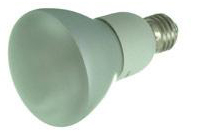
Comparing electricity bills over a full year with bills from previous years, the energy consumed was reduced by nearly 1500 kilowatt-hours over the year. At current electricity prices that saves over £200 per year, so the cost of the CFLs was paid back within a couple of months. But as noted above, we should really compare the price of one CFL with the ten or so ordinary bulbs that would be needed over its much longer lifetime. That probably makes the CFL cheaper to buy, even without taking the hugely reduced electricity consumption into account. Conclusion * At the present time, compact fluorescent bulbs are
a very effective way to reduce both energy usage and costs. For most domestic
purposes – apart from directional lighting – they are probably
the best choice at present, though LEDs are gradually taking over. Suggested wattages for low-energy bulbs When choosing low-energy bulbs, and also fluorescents, the equivalent wattage ratings given to replace existing incandescent bulbs are almost always too optimistic. The formula usually used is one-fifth or less of the incandescent wattage, and this is why many people say that low-energy lighting is not bright enough. These suggested ratings tend to be worst for smaller wattages, and for special packaging such as candle bulbs. In the table below we give more realistic values, which tend to be about one-quarter of the equivalent incandescent bulb wattage. It is also worth taking careful note of the light output, in lumens, on each bulb package. Recent designs are brighter than they were just a couple of years ago.
Passing current through special types of semiconductor diodes generates light. The colour generated depends on the materials making up the diode. For many years red, yellow and green LEDs have been used as indicator lights, or for simple alphabetic or numeric displays. LEDs can be shaped, for example to produce the widely used 7-segment numeric displays in digital clocks. The invention of blue and then ultraviolet LEDs led to the production of white LEDs. White-ish light is generated either by combining diodes using different materials, or by coating a diode generating ultraviolet with a suitable phosphor. The operating voltage across the diode is only about 1 volt, which means that battery operation is an attractive option. Another attractive feature is that they last far longer than ordinary lighting, with lifetimes claimed to be 50,000 hours or more. This makes them useful for reducing failures and maintenance, especially in safety-critical applications or in places that are difficult to access. For example, arrays of LEDs are now used for traffic lights, some car lights, etc. LEDs come on at full intensity, in contrast to CFLs. Although they are easy to dim in principle, many models do not allow this – if you want dimmable LEDs, check the packaging carefully before you buy them. They will also be somewhat more expensive than standard non-dimmable LEDs. Efficiency The light emitted by one diode is not very bright (though that is improving), but several diodes can be combined to make a light that is more compact and uses much less electrical energy than an incandescent bulb. Arrays of many diodes are fabricated using some of the same large-scale production techniques used for electronics. The light is emitted directionally, unlike domestic light bulbs, but that is a useful feature for many of the current applications such as torches, or replacements for halogen spotlights (photo at right) such as those widely used in kitchens and bathrooms. The efficiency of the brightest LEDs has been increasing steadily. Even at fairly low efficiencies (comparable to incandescents) they have the advantages of low-voltage operation and long life, and so have been in widespread use as indicator and illumination signs for quite some time. More recently, they have become widely used for compact, light-weight portable devices such as torches and bicycle lights because even small, low-power batteries produce sufficient light and last a very long time. LED lighting is under very active development. Efficiency is now comparable to or better than fluorescents or low-energy light bulbs, which means they generate very little heat. For the future it is generally expected that LEDs will become even more efficient, but in order to achieve this a problem called ‘LED droop’ has to be solved – this is a reduction in light output efficiency as the electrical current carried by the LED increases. Higher efficiency and improved production methods are steadily reducing the present relatively high prices of LED lights. 
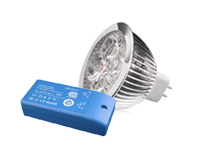
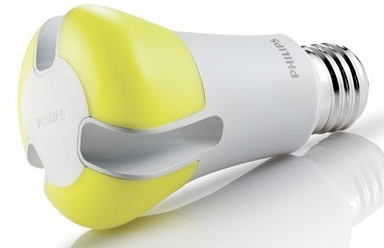
Fittings and types LED lighting for domestic use is still evolving rapidly, and new types and applications keep appearing. Some of the ‘white’ LED lights on sale still have the cold, blue-ish colour balance of early LEDs, but warm white lights are now widely available. The most common are replacements for halogen spotlight arrays. There are direct equivalents for mains-voltage bulbs (e.g. GU10, photo at left above). For low-voltage bulbs (e.g. MR16) it is also necessary to replace the small transformers used for the halogen bulbs with ‘drivers’ (photo of MR16 bulb and driver module at centre). However, if a large number of bulbs is being replaced it may be cheaper and more efficient to install a single low-voltage power supply for the entire room. The type of driver or power supply needed may be different if you wish to dim the bulbs. What wattage is needed is not always clear, since different brands make very different claims about light output. Although the output in lumens given on the package is helpful, care is needed in comparing directional bulbs if their output covers different angles. If you are replacing a number of halogen bulbs it is a good idea to try one or two LED equivalents first in order to check that they give out the desired amount of light and that the colour balance (warm white usually preferred) is acceptable. Small LED-based reading lamps are becoming more common. Strips of LEDs to provide concealed background lighting are available. Overcoming the directionality of LEDs is difficult, but good replacements for ordinary, omni-directional light bulbs are now on the market, though beware that they often do not emit much light towards their base. (Photo at right above is of a 60-watt bulb replacement that won a US Dept. of Energy prize). However, bulbs equivalent to more than about 60–80 watt incandescents are not yet available and prices are high. Replacements for fluorescent tubes are also available, though again very expensive, and note that they tend to be directional. The price of LEDs is still high. Although the savings due to their high efficiency and very long lives are considerable, the up-front cost of replacing a substantial number of lights (e.g. halogen spotlights) in many houses is considerable, and the cost of the newer omni-directional bulbs and fluorescent tube replacements is even higher. However, prices are dropping steadily. LED lighting has huge potential in the future. Producers predict that efficiencies two or three times better than fluorescent lights seem possible. When this is combined with ways to produce diffused light to fill a room, there is a possibility of a true revolution in lighting since arrays of LEDs need not come in the form of bulky bulbs or tubes. Rooms might be lit by large-area flat panels or interesting shapes. End of life Light-emitting diode lights would generally be classified with other electronic goods, and should be brought to local waste recycling centres. Conclusion * Light-emitting diodes are the future. They are already the best choice for directional lighting, replacing halogen spotlights, and some omni-directional models would be a good choice. However, more development is needed to produce omni-directional lamps with higher outputs and reduce their cost before they can become a complete solution for general domestic lighting. Manufacturers These are some of the main companies producing low-energy lamps, with links to their websites: GE
Lighting Suppliers Common styles and sizes of low-energy bulbs (CFLs), fluorescent tubes and LED lights can be obtained from supermarkets, electrical, and DIY stores. There are often special deals (subsidised by energy supply companies), especially on packs of several CFL bulbs. However, the choice available tends to be quite limited, e.g. if you want CFLs of more than 20 watts. A wide range of lamps
can be bought or ordered from: Internet sources can be less expensive, particularly if buying in any quantity, and offer a very full range if you look around. Some useful suppliers (in alphabetical order) are: BLT Direct |
 |
If you have any comments or queries about this website please contact the
webmaster. |
© Blewbury Energy Initiative 2017 |